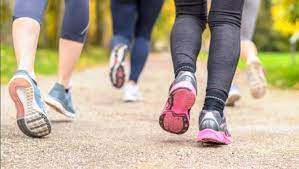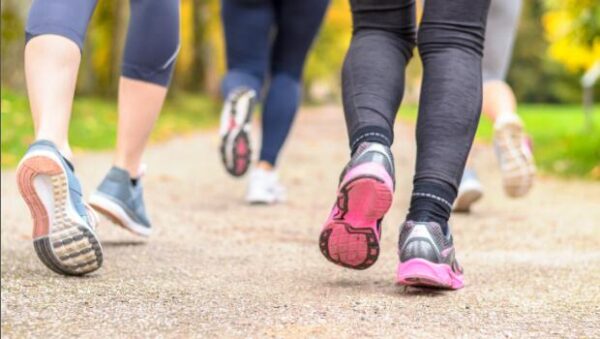We all know that we should get more exercise, but finding the time to work out can be a real challenge. With so many of us leading increasingly busy lives it can be hard to find time to exercise. Even so, it is important to carve out that time. Walking, running and other popular forms of exercise carry with them a host of health benefits, including reduced cholesterol levels, reduced risks of heart disease and stroke and of course a greater sense of well being.
Working out on a regular basis is also a great way to boost your overall energy level, giving you more energy to do all you have to do each day. In addition walking and running can help you stay alert and focused, certainly an important benefit for busy workers and college students.
Enjoy the Many Benefits of Walking and Running

If you are planning to start a walking or running regimen you probably have a number of questions. One of the most commonly asked questions is which type of walking is best in terms of overall health benefits and number of calories burned. Many people wonder if power walking or race walking will provide superior benefits to a more casual stroll or more relaxed pace.
The simple answer is that you will bum roughly the same number of calories for each mile you cover regardless of how fast you cover that mile. The exact number of calories burned will vary from individual to individual, but for the most part a 150 pound person will bum about 100 calories per mile, while a 200 pound individual will bum about 130 calories for each mile traveled.
This rough calorie count holds true whether you are strolling, walking briskly, jogging or running. The benefit of moving faster, of course, is that you can cover more ground (and bum more calories) when you walk faster or run. So if you are pressed for time you can take a brisk power walk and get the same benefits you would achieve with a much longer stroll around the neighborhood.
Helpful Post: https://wethebrainys.com/mind-lab-pro-review/
Types of Walking
Many people are surprised to learn that there is more than one way to walk, but it is true. The variety of walking styles available makes it easier to stick to your exercise regimen and make it over those rough patches-when you get bored with one type of walking you can simply switch to a style that suits you better. To get you off to a good start let’s take a look at some of the most popular ways to walk.
Traditional walking
When most people walk at a normal pace they will cover approximately 3 to 4 miles in an hour. This pace is a good choice for those just starting their walking regimen, and it is a good fit for a stroll around the neighborhood or walking the dog.
Race walking
If you are looking for something a little more challenging you may want to give race walking a try. Race walking is a particularly good choice for those who have problems jogging or running due to joint problems or bad knees. Race walking provides many of the same benefits of running, but with lower impact and less chance for injury. When you race walk you will lengthen your stride and pick up the pace significantly from a normal walk.
Power walking
Power walking is much like race walking, but at a slightly slower pace. Power walkers really get into the swing of things as they move at a fast pace and enjoy a great workout. The stride of the power walker is longer and more brisk than that of a normal walker, but not quite as long or as fast as the race walker.
Water walking
For the ultimate in low impact exercise why not grab your bathing suit and head out to your backyard or the local pool? Water walking is a great way to get a surprisingly intense workout with much less risk of injury and joint problems. In fact a half hour of water walking burns the same number of calories as an hour of traditional walking, due to the increased resistance provided by the water. Many gyms even have water walking classes, providing additional motivation and support for your healthy lifestyle.
Hiking and Mountain Trekking
Walking can be a lot of fun, but walking around the neighborhood can get boring pretty quickly. So why not take your favorite exercise to a new level with a brisk hike through the wood s or a strenuous trek through the mountains. There are many hiking clubs around the country, making it easy to find kindred spirits and get some great exercise in the great outdoors.
Of course some people will want to go a bit faster than even the fastest race walk, and running can be an excellent way to vary your exercise routine while enjoying even more of a cardiovascular workout. Both jogging and running can provide some excellent health benefits, including better heart health, decreased risk for many chronic conditions and diseases and a greater overall sense of well being. As with walking, there are many distinct types of running, making it easy for men and women to vary their workouts and keep their exercise routines fresh. From a slog job around the neighborhood to a strenuous run through the mountains, there are many great ways to stay fit. Some of the most popular and effective types of running include:
Jogging
Nothing is quite as refreshing as an early morning jog around the neighborhood, and jogging remains one of the most popular forms of exercise for men and women alike. Those taking up the sport for the first time should be sure to invest in a quality pair of jogging shoes to lessen the potential for injury and joint damage.
Adventure Running
This popular type of running is a great way to enjoy the great outdoors while still getting a great workout. Some people love to run through the mountains, relishing the varied terrain and elevations, while others prefer a brisk run down their favorite hiking path.
Road Running
Road running is just what the name implies – running along a favorite roadway or thoroughfare. A brisk run along the road provides a great cardiovascular workout and many other health benefits

